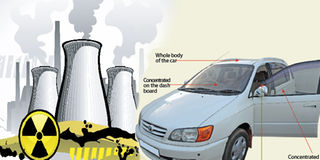Radioactive Japanese cars on the market

What you need to know:
The second hand vehicles appear to be outwardly sound but were owned by people living close to the Fukushima nuclear plant earthquake and tsunami.
Kampala.
Car dealers in the country are selling vehicles that were contaminated by radiation following the Japanese earthquake and tsunami that resulted in a series of meltdowns at the Fukushima Daiichi nuclear plant.
Sunday Monitor can reveal that a large number of second hand radioactive vehicles that originated from Japan exclusion zone that surrounds the Fukushima prefecture’s power plant have made their way into the used car market in the country. However, what is more worrying is the fact that government is sitting on a report warning that the effects could be fatal. The report was made to it in January 2012.
Most of the radioactive material is said to settle on the body of the car, windows and the seats.
And while neighbouring Kenya and Tanzania have since blocked the importation of such cars into their markets, Uganda, despite sending a taxpayers’ funded delegation to Japan last year, has not taken action on the findings of this delegation.
There is, however, no data to show how many of such contaminated vehicles have entered the country. URA revealed on KFM on Wednesday that between 4,000 to 5,000 vehicles minus motorcycles enter the country monthly from various countries.
MP Stephen Kasaija Kagwera, who heads the House committee on trade, led the five member team that included officials from Uganda National Bureau of Standards. “The most critical issue that calls for immediate action established during the visit is contamination of motor vehicles bound for Uganda by ionizing radiation,” reads the report. “During the visit, it was established, through random scientific tests as well as motor vehicle inspection records, that many used motor vehicles destined for export markets from Japan, are contaminated with significantly high levels of ionizing radiation, way above recommended levels.”
Trade minister Amelia Kyambadde told Sunday Monitor that she had not seen the report but “they could have submitted it and some people stifled it. I am going to ask my PS; sometimes they don’t tell me.” However, this newspaper understands that government feared to act on the report for fear that it could have economic repercussions but some officials say there is need to prioritise the health of car users.
Ms Kyambadde, however, revealed that recently a section of Ugandan car importers complained to her that Kenyan authorities had destroyed their cars at Mombasa. “But the Kenyans told me the cars were destroyed because they had nuclear radiation,” she revealed.
Kenyan government has hired Japanese firms to test the cars destined to their market before they are shipped. Sources have told this newspaper that despite reminders by the Japanese Embassy in Kampala to government of the need to check the cars before they leave Japan, there has been inaction since September last year when the matter was brought to government’s attention.
“It is a well-known scientific fact that exposure to ionizing radiation, even at low levels, carries the risk and increases the probability of the victim suffering from cancer, cataracts and adverse hereditary effects. Children and women (mainly pregnant) are more vulnerable to ionizing radiation,” reads the report.
In March 2011, an earthquake and tsunami hit Fukushima in Japan, severely damaging the Dai-ichi Nuclear Power Plant leading to release of radioactive substances in the atmosphere and contamination.
The report says preliminary reports indicated that a big array of goods was contaminated by radiation, including motor vehicles located tens of kilometres away as radioactive material was carried by rain and on vehicle wheels.
“Also, there were reports that some deceitful gangs were involved in disguising motor vehicles sourced near the epicenter of the nuclear disaster and exporting them to unsuspecting countries.”
The findings show that gamma radiation contamination cannot be cleaned off the affected surface and it has high penetrative strength, for instance, the ability to penetrate through any material, say a layer of concrete three metres thick.
“The foregoing, when compared to motor vehicles that are made of metal sheeting only a few millimetres of thickness, illustrates the grim threat to automobile users in Uganda,” reads the report, adding: “Spare parts from contaminated vehicles are most likely going to find their way on the local market. Added to this are parts from washed vehicles that were sub-merged in the floods after the Tsunami struck Japan.”
The Ugandan delegation found that further tests at an inspection facility operated by East Africa Automobiles Services Company Limited at Yokohama was to reveal startling results, including a vehicle quarantine section with over six cars that had failed radiation tests, with some logging up to five times the recommended levels.
Unsurprisingly, one of the contaminated vehicles was destined to Uganda. The affected vehicles are varied from the top of the range SUVs and ordinary ones affordable to many Ugandan cars owners.




